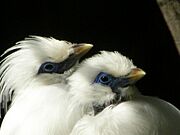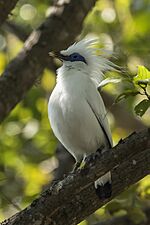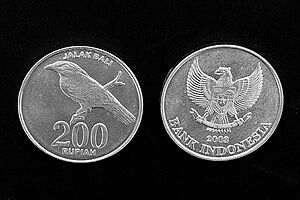Bali myna facts for kids
Quick facts for kids Bali myna |
|
|---|---|
 |
|
| In West Bali National Park | |
| Conservation status | |
| Scientific classification | |
| Genus: |
Leucopsar
|
| Species: |
rothschildi
|
The Bali myna (Leucopsar rothschildi), also known as Rothschild's mynah or Bali starling, is a special bird from Bali, Indonesia. Locals call it jalak Bali. It's a medium-sized bird, about 25 cm (10 inches) long. It is mostly white with a long, droopy crest on its head. Its wing and tail tips are black. This bird has blue skin around its eyes, grey legs, and a yellow beak. Both male and female Bali mynas look very similar.
Sadly, the Bali myna is critically endangered. This means it is very close to disappearing forever. In 2020, experts believed fewer than 50 adult birds were left in the wild.
Contents
How the Bali Myna Got Its Name
The Bali myna was first officially described in 1912. A German bird expert named Erwin Stresemann gave it its scientific name. He studied a female bird found on the island of Bali in Indonesia.
Stresemann created a new group, or genus, for this bird, called Leucopsar. He named the species rothschildi. The name Leucopsar comes from old Greek words meaning "white starling." The name rothschildi honors Walter Rothschild, a famous collector who let Stresemann study birds at his museum.
The Bali myna is the only species in the Leucopsar group. This makes it quite unique!
What Does the Bali Myna Look Like?
The Bali myna is a medium-sized starling, about 25 cm (10 inches) long. It is almost completely white. It has a long, hanging crest on its head. The tips of its wings and tail are black. It has a yellow beak and bright blue skin around its eyes. Its legs are grey.
Male and female Bali mynas look alike. However, the male usually has a longer crest than the female. Another bird, the black-winged myna, looks a bit similar. But it has a shorter crest and more black on its wings and tail. It also has a yellow ring around its eye, not blue skin.
Where Do Bali Mynas Live?
The Bali myna lives only in the northwest part of Bali, Indonesia. It also lives on some small islands nearby. This means it is an endemic species, found nowhere else in the world.
In 1991, the Bali myna became the official bird symbol of Bali. You can even see it on the Indonesian 200 rupiah coin! Its local name is jalak Bali.
Bali Myna Behaviour
In the wild, Bali mynas are hard to spot. They usually stay hidden in the tops of trees. Unlike other starlings, they only come to the ground to drink water or find things for their nests. This helps them hide from predators who might see them easily in open areas.
Young Bali mynas often gather in groups. This helps them find food better and watch out for danger. Their calls are sharp, chattering sounds and loud tweets.
What Do Bali Mynas Eat?
The Bali myna eats a variety of foods. Their diet includes fruits, seeds, worms, and insects.
How Do Bali Mynas Breed?
During the rainy season in Bali, which is their breeding time, male mynas try to attract females. They do this by calling loudly and bobbing their heads up and down.
The birds build their nests inside tree holes. The female lays and sits on two or three eggs. After the chicks hatch, both the male and female parents bring food to the nest for their young.
Protecting the Bali Myna
The Bali myna is a critically endangered bird. Its wild population has been very low for many years. By 2015, fewer than 100 adult birds were thought to be in the wild. However, about 1,000 Bali mynas live in zoos and special breeding programs.
The Bali myna is listed in Appendix I of CITES. This means trading these birds, even those born in captivity, is very strict. It is usually not legal for private people to own them. But experienced bird breeders can join special programs to help breed them. Sadly, many birds are still bought illegally on the black market.
In 2018, wild Bali mynas were found in three places on Bali:
- The West Bali National Park
- Bali's small island of Nusa Penida
- A breeding and release site at Melinggih Kelod, Payangan, run by the Begawan Foundation.
Bali Myna Breeding Programs
Some programs involve "breeding loans." For example, 12 breeders each received 15 male and 15 female mynas from a conservation group. They had to promise to release 10 percent of the baby birds into West Bali National Park. They could sell the rest.
The National Aviary in Pittsburgh, Pennsylvania also has a pair of Bali mynas. They are part of a Species Survival Program to help save the birds.
West Bali National Park Challenges
In the 1980s, about 350 Bali mynas lived in the West Bali National Park. In the 1990s, over 400 birds raised in cages were released there to boost numbers. But by 2005, park officials thought fewer than 10 birds were left. This big drop happened mainly because poachers caught the birds to sell them illegally.
Nusa Penida Island Sanctuary
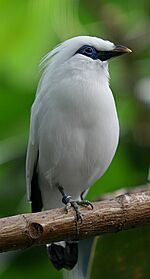
Now, some Bali mynas live on the island of Nusa Penida and its nearby islands, Nusa Ceningan and Nusa Lembongan. These islands are about 14 km (9 miles) off Bali's southeast coast.
A group called Friends of National Parks Foundation (FNPF) has turned these islands into a bird sanctuary. They worked with over 40 villages to create local rules. These rules protect birds and stop poachers. FNPF has released many endangered birds, including Bali mynas, onto Nusa Penida.
The Begawan Foundation also started a Bali Starling Breeding Program in 1999. They released 64 birds on Nusa Penida in 2006 and 2007. By 2009, their numbers had grown to over 100. The foundation plans to release about 10 Bali mynas each year. They get birds from different breeders to keep the wild population genetically healthy.
However, a check in 2015 found fewer than 15 birds flying in the wild on Nusa Penida and Nusa Lembongan. This suggests that illegal wildlife trade is still a big problem, even with all the efforts.
Sibang, Central Bali Efforts
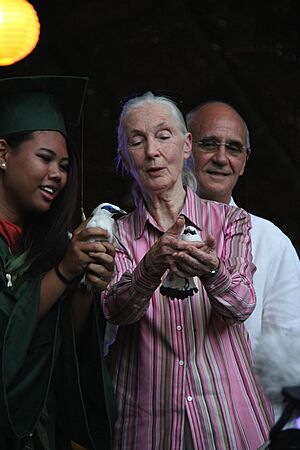
In 2010, the Begawan Foundation moved its Bali myna breeding program to Sibang, near Ubud. They wanted to find new places to release birds nearby. In 2011, 23 Bali starlings were given to the program. Three came from Jurong Bird Park, and 20 came from zoos in Europe. These new birds helped add new genes to the local bird population.
In 2012, the foundation released four pairs of Bali starlings at their Sibang site. Staff and students watched these birds daily. Local villages fully supported the conservation program. Each bird was given a ring to identify it. The birds could return to the breeding site for food and water, but they also found plenty of food in the wild.
In 2014, more birds were released in Sibang. In June, Dr. Jane Goodall, a famous conservationist, even helped release two Bali starlings.
Melinggih Kelod, Payangan Community Program
In late 2017, the Begawan Foundation moved its programs to Melinggih Kelod, Payangan. Here, they started a community-based conservation program. Local people can now breed Bali starlings. They can release the offspring into the wild after two years. The community also helps protect the birds in the wild.
In November 2018, the village made a local law called an "awik-awik." This law says that shooting, trapping, or hunting Bali starlings or any other protected wildlife is against the rules. Anyone caught doing this has to pay a large fine of 10,000,000 Indonesian Rupiah (about $650 USD).
The foundation also released more starlings in late 2018. This created a wild flock protected by the community. They hope this will help the birds reproduce in the wild. They also hope to create eco-tourism to help the village earn money.
The foundation's breeding and release center is now in Banjar Begawan, part of Melinggih Kelod. This center is open to the community and the public.
Images for kids




